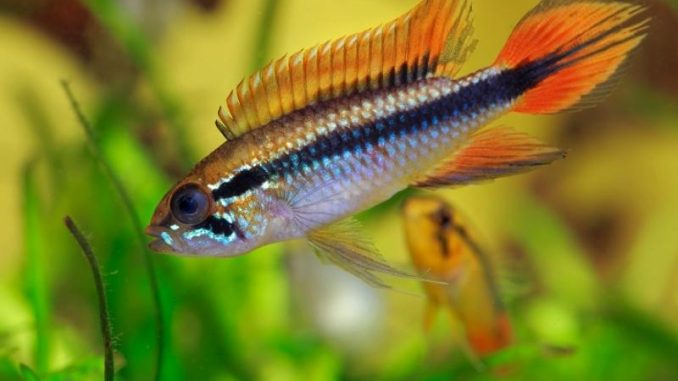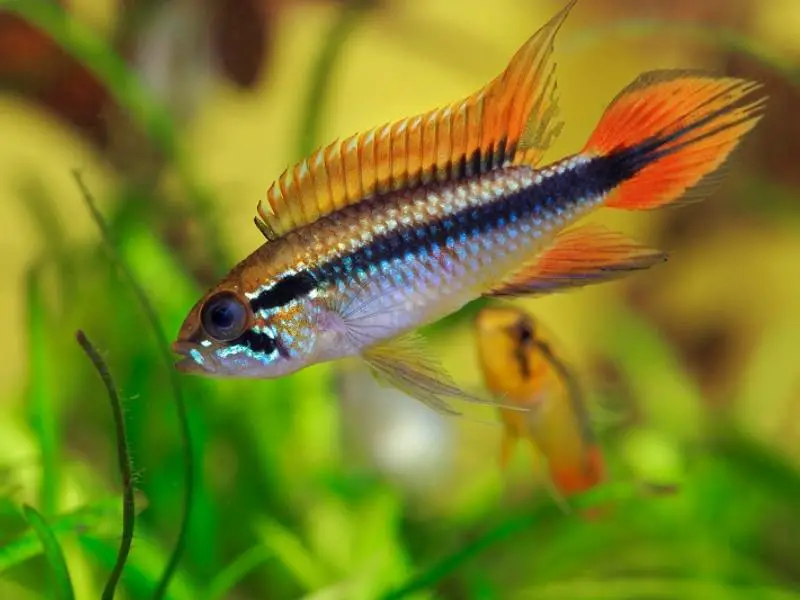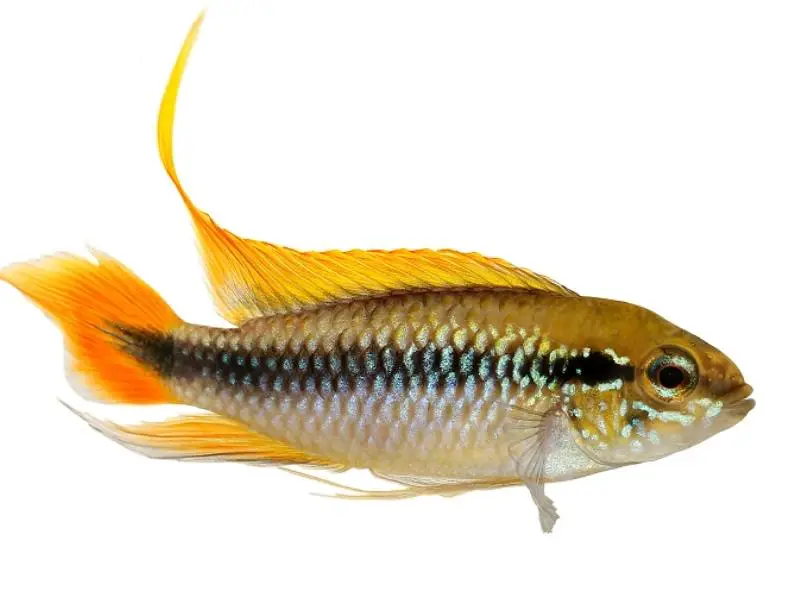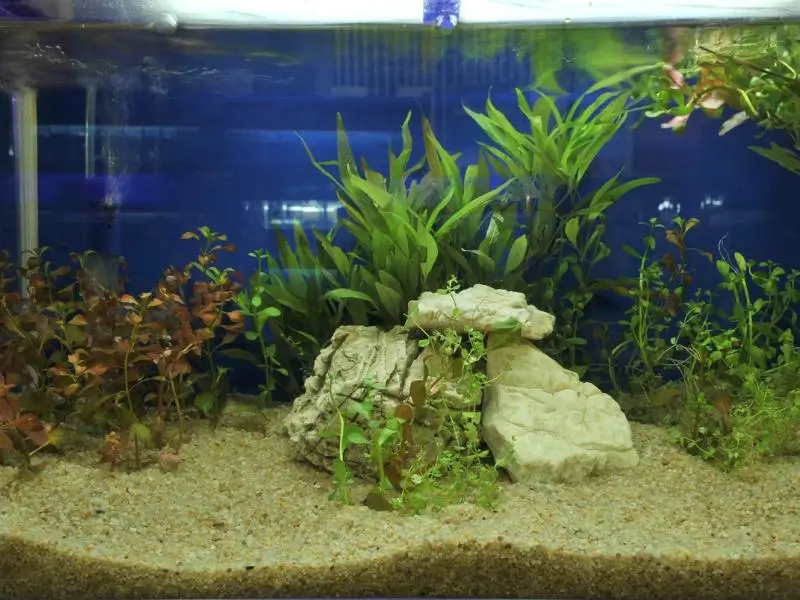
Apistogramma is a tropical freshwater fish genus from the Cichlidae family and is commonly kept in home aquariums. There are several species in the genus Apistogramma.
These dwarf cichlids enchant the aquarist with their vibrant colors and energetic persona.
Apistogramma is popular among experienced aquarists because these fish are easy to breed and care for.
TABLE OF CONTENTS
Apistogramma Facts & Overview

| Scientific name | Apistogramma agassizii |
| Common name | Apistogramma, Agassiz's dwarf cichlid |
| Distribution | South America |
| Size | 2.5–3 inches |
| Life expectancy | 5–10 years |
| Color | Yellow, blue, red |
| Diet | Different kinds of worms and larvae |
| Temperament | Semi-aggressive |
| Temperature | 75–81°F |
| Tank size | 20 gallons |
| pH | 6–7 |
| Hardness | 0–8 dGH |
| Care level | Easy |
| Breeding | Easy |
Origin
Apistogramma is mostly found in specific regions of South America, particularly in the slow-moving waters of the Amazon River basin.
Although most prefer shallower settings, some of these fish also inhabit the borders of bigger lakes.
Certain species can be found in deeper, fast-moving water in more open environments, or at the surface amid floating plants.
However, most species prefer protected areas with leaf litter on the bottom in water that is shallow, up to about 1.3 feet.
These fish may become endangered in the future.
Adult Size & Lifespan
Apistogramma has a lifespan of 5–10 years. However, they may live longer if provided with better water conditions and surroundings.
In contrast to most fish in the Cichlidae family, the Apistogramma is a smaller fish, growing to a maximum of 0.8–3 inches.
Availability
These fish are readily available at pet stores. The cost of this fish ranges from $25–$50.
Appearance & Behavior

The usual appearance of Apistogramma fish is vibrant yellow with a tinge of blue and red. The color pattern of this fish varies a lot, which can be fun and entertaining.
Colors, Patterns, Fins, and Sex Differences
There are approximately 90 different types of Apistogramma fish, and scientists are still finding more.
Different species are found in different parts of South America. Some common species include:
- Apistogramma Trifasciata:
- Apistogramma Agassizii
- Apistogramma Viejita
- Apistogramma Elizabethae
- Apistogramma Cacatuoides
- Apistogramma Macmasteri
- Apistogramma Hongsloi
- Apistogramma Baenschi
- Apistogramma Borellii
Typical Behavior
Apistogramma has sexually distinct genders, and there are differences in appearance. Females are often smaller than males and have more muted color patterns.
Males have more vibrant hues. However, females’ colors become brighter during the mating season.
Tank Requirements

Due to the Apistogramma’s small size, a small tank with 20 gallons of capacity works well. More space is preferred if you want to keep more than two fish.
Habitat and Tank Setup
Providing natural and comfortable surroundings helps your fish live longer. Add a fine sandy substrate with leaves to your fish tank.
The sandy bottom is good for live aquatic plants. Lush vegetation in your fish’s environment provides food and hiding places for protection.
Tank Conditions
- Water type: freshwater
- Tank size: minimum 20 gallons,
- Water temperature: 75–81°F
- Substrate: Sand, rock
- Tank setup: Plants and vegetation
- Acidity: 6–7 pH level
- Water hardness: 10–15 dGH
- Filter: Yes
Common Apistogramma Health Issues and Diseases
Apistogramma is prone to parasite infections and Ich, as well as other common freshwater diseases.
These problems are usually caused by low water quality or stress. Untreated, these problems may result in illness or death.
To prevent these health issues, maintain good water quality and correct water parameters in your fish tank.
Tank Mates
Apistogramma is best kept with other peaceful fish species. Due to their small size, these fish shouldn’t be kept with aggressive species that could eat them.
Good tank mates for Apistogramma include:
- Bristlenose plecos
- Pencilfish
- Neon tetras
- Otocinclus catfish
- Rasboras
- Cardinal tetras
You may also keep multiple Apistogramma in your tank. But be sure to keep more females than males to prevent aggression in males.
Diet and Feeding
Apistogramma is classified as omnivores and eats green plants and algae.
However, they can also eat meaty foods like baby brine shrimp, larvae, and micro worms. Feed the fish 3–4 times per day.
Breeding the Apistogramma
Breeding Apistogramma is easy. However, proper tank conditions are necessary. A mated couple should be put in a separate tank with at least 10 gallons to start the reproductive process.
Lower the tank’s water flow while simultaneously raising the tank’s water temperature to 80°F.
The eggs hatch in 2 to 5 days on average. During this period, the male and female will patrol the area, driving away any fish that comes too close.
Therefore, it’s best to keep the pair in a separate tank.
Should You Get an Apistogramma for Your Aquarium?
Apistogramma fish are a good choice for aquarists looking for less expensive fish.
These fish like to reside at the bottom of the tank, so they get along with any species that doesn’t take up important floor space there.
FAQs
How big does an Apistogramma get?
Apistogramma grows to an adult length of about 3 inches.
How many Apistogramma should be kept together?
It is advisable to keep more than one Apistogramma in a tank. Experts always recommend having more females than males to avoid aggressive male behavior.
What fish can live with Apistogramma?
Here are some of the preferred Apistogramma tank companions:
- Same species
- Pencil fish
- Neon Tetras
- Pygmy Corydoras
- Rasboras
- Cardinal Tetras
- Otocinclus Catfish
Does Apistogramma produce a lot of waste?
Despite their small size, Apistogramma can create significant waste. A top-notch canister filter with carbon filtering media, like the Fluval FX4, will maintain good water quality.


Be the first to comment